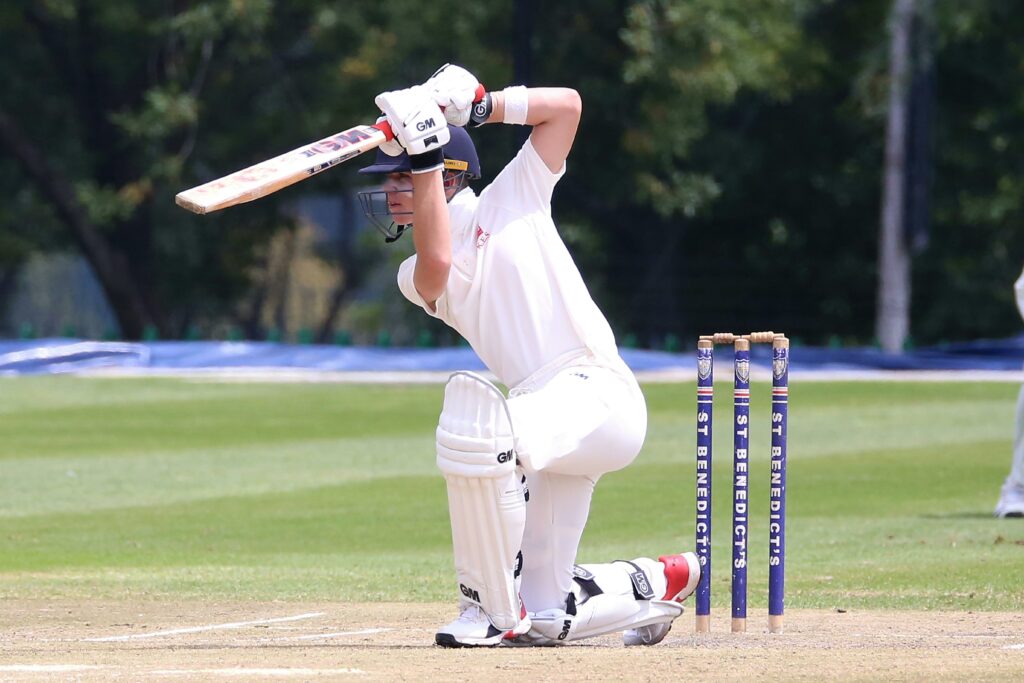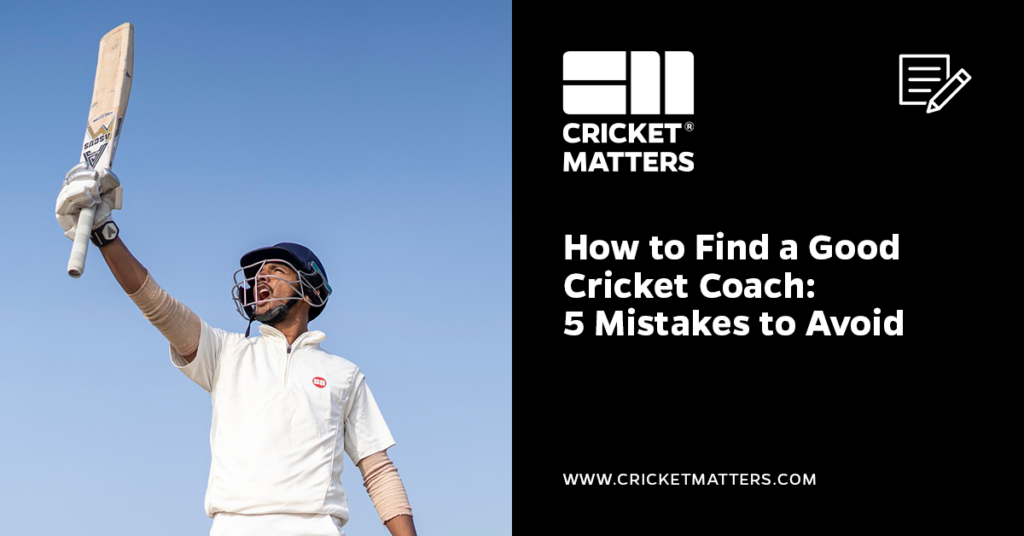
I hope you enjoy reading this blog post.
James Breese, Cricket Matters FounderIf you need my help with cricket coaching, strength and conditioning, injury rehab, or nutrition, click here.
In recent years, the world of sports has witnessed a significant shift in how athletes train, learn, and develop their skills.
Among the various innovations, online coaching has emerged as a game-changer, particularly in sports like cricket.
Whether you’re an aspiring cricketer aiming to improve your batting technique or a seasoned player looking to refine your bowling skills, online cricket coaching offers a new and flexible way to achieve your goals.
In this article, we look at the benefits of online cricket coaching to help you decide whether it’s the right option for you or your children.
Table of Contents
The Rise of Online Cricket Coaching

The rise of online cricket coaching can be attributed to rapid technological advancements and the increasing demand for personalised, accessible training.
Gone are the days when geography, time constraints, or the availability of local coaches limited aspiring cricketers.
Today, thanks to high-speed internet, video conferencing tools, and sophisticated training platforms, players can connect with expert coaches worldwide without leaving their homes.
This digital revolution in coaching has been accelerated by recent global events, notably the COVID-19 pandemic, which forced many traditional training methods to adapt or halt altogether.
During this period, online coaching became a convenient and necessary option, allowing athletes to continue their training routines despite the challenges posed by lockdowns and social distancing measures.
However, the appeal of online cricket coaching extends beyond mere convenience.
It offers flexibility and accessibility that traditional in-person coaching often cannot match.
Whether balancing school, work, or other commitments, online coaching allows you to train at your own pace and schedule. This flexibility primarily benefits young athletes and those in remote areas with limited access to quality coaching.
Moreover, technology has made it possible for online coaching to be highly effective.
Video analysis software, interactive training apps, and instant messaging allow real-time feedback and personalised training plans.
Coaches can analyse your batting stance, critique your bowling action, or fine-tune your fielding techniques, all through a screen.
This immediacy and precision have made online coaching attractive for cricketers at all levels.
A Proven Track Record in Online Fitness Coaching
As someone deeply involved in online coaching since 2015, I’ve had the unique opportunity to witness firsthand the transformative power of virtual training.
My journey began in the world of fitness, strength, and conditioning, where I’ve spent years helping athletes and fitness enthusiasts achieve their goals through online platforms.
Through our sister company, Strength Matters, we’ve been pioneers in this space, travelling the globe to teach other coaches, trainers, and gyms how to implement online coaching programs effectively.
This extensive experience in the online fitness industry has equipped me with valuable insights into the benefits and challenges of remote coaching.
The lessons I’ve learned from working with athletes remotely are now being applied to the cricket world.
I see tremendous potential for online coaching to revolutionise players’ training and development skills.
My goal with this article is to help you explore the growing trend of online cricket coaching, examine its benefits and challenges, and discuss how a hybrid coaching model—combining the best of online and in-person training—can offer cricketers an unparalleled training experience.
Whether you are new to online cricket coaching or looking to refine your approach, this guide will provide the knowledge and insights to improve your cricketing skills.
The Top Benefits of Online Cricket Coaching

As the world of cricket evolves, so too do the methods by which players train and improve their skills.
Online cricket coaching has emerged as a powerful tool, offering a range of benefits that can significantly enhance a player’s development.
From the convenience of flexible training schedules to the ability to connect with top coaches globally, online coaching is transforming how cricketers approach their training.
In this section, we’ll explore some of the top benefits of online cricket coaching and how it can help you take your game to the next level.
1. Accessibility and Flexibility
In today’s fast-paced world, people crave accessibility and flexibility to balance their busy lives, making it easier to pursue personal goals without sacrificing other commitments.
One of the most significant advantages of online cricket coaching is the unparalleled accessibility and flexibility it offers to players of all levels.
Whether you’re a young cricketer just starting or an experienced player looking to fine-tune your skills, online coaching allows you to train when and where it suits you best.
This level of convenience is a game-changer, especially in today’s fast-paced world, where balancing multiple commitments can be challenging.
Gone are the days when athletes had to be physically present at a specific location to receive quality coaching.
With online cricket coaching, you only need a reliable internet connection and a device to connect with your coach.
This means you can practice your batting technique in your backyard, work on your bowling skills in a local park, or even receive feedback on your fielding from the comfort of your living room.
The flexibility of online coaching allows you to fit training into your schedule rather than the other way around.
A study by Mears et al. (2012) highlights the importance of this flexibility. The study examined the impact of flexible training schedules on athletes’ performance and overall well-being.
The study found that athletes who could train at times that suited their schedules experienced less stress and were more consistent in their training efforts.
This consistency led to better long-term performance outcomes than athletes confined to rigid, in-person training schedules.
This flexibility is particularly beneficial for cricketers.
The sport requires diverse skills, from batting and bowling to fielding and strategy, each of which can be honed through focused, individualised practice sessions.
Online coaching allows you to dedicate time to these areas without the constraints of traditional coaching schedules, ensuring you can make the most of every training session.
Additionally, online coaching eliminates geographical barriers.
Previously, access to top-level coaching was often restricted to players living in or near major cricketing hubs.
This was particularly true for my development as a kid. My parents had to drive me one hour to practice one way. I wish online coaching had been available to me back in the ’90s.
With online coaching, you can connect with expert coaches from anywhere in the world, gaining insights and feedback that might have previously been impossible to access.
This opens up opportunities for cricketers, no matter where they are based.
In Summary
The accessibility and flexibility offered by online cricket coaching allow players to train on their terms, leading to more consistent practice, reduced stress, and improved performance.
Whether juggling school, work, or other commitments, online coaching allows you to keep improving your cricket skills without sacrificing other important aspects of your life.
2. Enhanced Coach-Athlete Relationships

One of the most critical aspects of any successful coaching program is the relationship between the coach and the athlete.
Traditionally, this relationship has thrived on face-to-face interactions, where trust, communication, and understanding are built over time.
However, with the advent of online coaching, many might wonder whether these vital elements can be maintained when coach and athlete are not physically together.
The good news is that, thanks to modern technology, online platforms have proven highly effective in fostering and enhancing these connections.
Despite the physical distance inherent in online coaching, various digital tools allow coaches and athletes to stay closely connected.
Video conferencing platforms, instant messaging apps, and even specialised coaching software have created a seamless communication experience.
These tools enable real-time feedback, allowing coaches to provide immediate guidance, corrections, and encouragement—just as they would in a face-to-face setting.
A study by Blanchfield et al. (2023) delves into the effectiveness of technology in bridging the communication gap between coaches and athletes in online environments.
The research found that athletes who engaged in regular, structured communication with their coaches through online platforms reported feeling just as supported and understood as those who trained in person.
The study highlighted that the frequency and quality of communication often improved in an online setting, as both parties could engage more flexibly and consistently.
Furthermore, the digital nature of online coaching allows for the recording and playback of training sessions.
This helps track progress over time and ensures that athletes can revisit their coach’s feedback whenever they need it, reinforcing learning and improving skill retention.
This ongoing interaction strengthens the coach-athlete bond, as athletes feel continuously supported in their journey, even when they’re not training in real-time.
In Summary
Online coaching platforms have proven highly effective in maintaining strong coach-athlete relationships.
Through regular, structured communication and technology, these connections can be just as strong—if not stronger—than those in traditional, in-person coaching environments.
This ensures that athletes receive the guidance, support, and motivation they need to excel, even when physical distance separates them from their coaches.
3. Psychological Skills Development

In sports, physical ability is just one piece of the puzzle.
Developing strong psychological skills is equally crucial for achieving peak performance, particularly in a mentally demanding sport like cricket.
Online coaching programs have increasingly recognised the importance of integrating mental toughness, goal-setting, and other psychological skills into their training regimens, ensuring that athletes are well-prepared to handle the pressures of competition.
Mental resilience is often what separates good athletes from great ones.
It involves maintaining focus, staying resilient in the face of adversity, and performing under pressure—qualities that are essential for any cricketer. Online coaching programs are uniquely positioned to offer targeted psychological training as part of their curriculum.
Through structured sessions, coaches can guide athletes in developing strategies to enhance their mental fortitude, helping them to remain composed and confident, whether going out to bat or facing a fast bowler for the first time.
Goal-setting is another critical component of psychological skills development.
In an online coaching environment, coaches can work closely with athletes to set specific, measurable, achievable, relevant, and time-bound (SMART) goals.
These goals provide a clear roadmap for progress, allowing athletes to focus their efforts and track their achievements over time.
The digital nature of online coaching also means that progress can be monitored more easily. Coaches and athletes regularly review and adjust goals to keep motivation high.
The importance of these psychological skills in athletic performance is well-documented.
Camiré & Trudel (2014) emphasise the significant role that mental skills play in an athlete’s development and success.
Their research highlights how athletes equipped with strong psychological skills are better able to cope with the demands of their sport, leading to improved performance and greater overall satisfaction with their athletic experience.
Online coaching platforms often incorporate various tools to support psychological skills development.
These might include video analysis to help athletes visualise success, interactive exercises designed to build mental resilience, and regular feedback sessions encouraging self-reflection and growth.
By integrating these elements into the training process, online coaching ensures that athletes are not just physically prepared but also mentally equipped to excel.
In Summary
Psychological skills development is a crucial aspect of any athlete’s training, and online coaching platforms are well-suited to deliver this training effectively.
Online coaching helps cricketers build the resilience needed to perform at their best by focusing on mental toughness, goal-setting, and other key psychological strategies.
With the support of a knowledgeable coach and the convenience of digital tools, athletes can develop these skills in a way that complements their physical training, ultimately leading to a more well-rounded and successful sporting experience.
4. Personalised Training Programs

One of the standout advantages of online cricket coaching is the ability to deliver highly personalised training programs tailored to each athlete’s unique needs.
Unlike traditional group coaching sessions, where training is often designed to suit the general abilities of a group, online coaching offers the flexibility to focus on the specific strengths and weaknesses of an individual player.
This customised approach is invaluable in helping athletes reach their full potential.
In an online coaching environment, coaches can take the time to assess an athlete’s current skill level, performance goals, and areas for improvement.
Based on this assessment, they can design a training program that targets the athlete’s specific needs, whether refining a particular batting technique, improving bowling accuracy, or enhancing overall fitness.
The ability to focus on these individual aspects means that every session is maximised for efficiency and effectiveness, ensuring that the athlete makes consistent progress.
Moreover, personalised training is not static.
As athletes grow and improve, their needs evolve. Online coaching platforms allow coaches to continuously monitor performance and make real-time adjustments to the training plan.
This dynamic approach ensures that the program remains relevant and challenging, pushing the athlete towards higher levels of achievement.
Research supports the benefits of personalised online coaching.
Eagles and Callary (2023) highlight the effectiveness of customized coaching programs in improving athletic performance.
Their study found that athletes who received tailored coaching were more likely to see significant improvement in their skills than those who participated in standardised training programs.
The research underscores the importance of addressing individual needs in sports coaching, particularly in a highly technical sport like cricket.
Personalised training also extends beyond technical skills.
Coaches can incorporate elements of mental conditioning, nutrition advice, and fitness routines specific to the athlete’s goals.
For instance, a fast bowler might receive a tailored strength and conditioning plan focusing on building explosive power.
At the same time, a batsman might work on concentration techniques to enhance performance under pressure.
This holistic approach ensures that every aspect of the athlete’s development is catered to, leading to more comprehensive growth.
In Summary
Personalised training programs are a key benefit of online cricket coaching, allowing athletes to work on their specific needs with precision and focus.
Research from Eagles & Callary (2023) supports the idea that customised coaching is more effective than one-size-fits-all approaches in driving performance improvements.
Online platforms facilitate this level of personalisation, allowing coaches to adapt training plans as athletes progress continuously.
This bespoke approach ensures that cricketers receive the most relevant and practical guidance on their journey to becoming better players.
5. Cost-Effectiveness

In addition to its many practical benefits, online cricket coaching is a highly cost-effective option for athletes looking to improve their skills without breaking the bank.
Traditional in-person coaching sessions often come with significant costs, including travel expenses, facility fees, and sometimes even the premium rates charged by high-demand coaches.
Online coaching, however, offers a more affordable alternative that doesn’t compromise the quality of training.
One of the primary financial advantages of online coaching is eliminating travel costs.
In-person coaching often requires athletes to travel to specific locations, which can be time-consuming and expensive, especially if the coach or training facility is far from home.
These travel expenses can add up quickly, particularly for athletes who need regular coaching sessions to maintain and develop their skills.
Online coaching removes this burden entirely, allowing athletes to train from the comfort of their own homes, local parks, or any convenient location.
Moreover, the overhead costs associated with physical facilities are generally absent in online coaching.
Coaches who offer online sessions can pass these savings on to their clients, resulting in more competitive pricing for the same, if not higher, quality of instruction.
This makes professional coaching accessible to a wider range of athletes, including those who might not have the financial resources to afford traditional, in-person coaching.
Research further supports the cost-effectiveness of online coaching.
A study by Mears et al. (2012) found that athletes who participated in online coaching programs experienced significant financial savings compared to those who relied solely on in-person sessions.
The study highlighted the reduction in travel-related expenses as a key factor contributing to the affordability of online coaching.
Additionally, the flexibility of online coaching often means fewer missed sessions due to scheduling conflicts, ensuring that athletes get the most value for their investment.
This financial accessibility can be a game-changer for cricketers. It opens up opportunities to receive expert coaching that might have otherwise been out of reach, particularly for those living in remote areas or those with tight budgets.
By choosing online coaching, athletes can invest in their development without the added financial stress, allowing them to focus entirely on improving their game.
In Summary
Online cricket coaching offers a cost-effective solution for athletes seeking high-quality training without the hefty price tag associated with traditional in-person sessions.
By eliminating travel costs and reducing overheads, online coaching makes professional coaching more accessible and affordable.
The research by Mears et al. (2012) underscores these financial advantages, highlighting how online coaching can provide significant savings while still delivering top-tier instruction.
Online coaching is an innovative and economical choice for cricketers looking to maximise their training budget.
6. Improved Athlete Motivation

Motivation is crucial in any athlete’s journey, driving both the desire to improve and the commitment to a rigorous training program.
Online cricket coaching has shown a remarkable ability to enhance intrinsic and extrinsic motivation, helping athletes stay engaged and motivated over the long term.
By leveraging technology and personalised coaching, virtual coaching can create a more motivating environment that fosters continuous improvement.
Intrinsic motivation, the internal drive to achieve personal goals and master new skills, is often strengthened through the personalised nature of online coaching.
When athletes receive tailored feedback and training plans that align with their specific needs and goals, they are likelier to feel a sense of ownership and pride in their progress.
This personal connection to their development can increase their intrinsic motivation, making them more eager to practice and refine their skills.
Extrinsic motivation, on the other hand, is driven by external factors such as rewards, recognition, or competition.
Online coaching platforms can enhance extrinsic motivation by incorporating progress tracking, performance benchmarks, and virtual leaderboards.
These features provide tangible markers of achievement, which can inspire athletes to push themselves harder to meet or surpass their goals.
The ability to see measurable progress, often visualised through data and video analysis, gives athletes a clear sense of advancement, further fueling their motivation.
Research by Eyck et al. (2006) highlights motivation’s critical role in sustaining long-term athletic engagement.
Their study found that athletes who experienced higher levels of both intrinsic and extrinsic motivation were more likely to remain committed to their training programs and achieve better results over time.
The study suggests that the key to maintaining this motivation lies in the ongoing support and encouragement coaches provide—something that online coaching platforms are well-equipped to deliver.
Online coaches can create an environment that keeps athletes focused and driven through regular communication, personalised feedback, and motivational tools.
This ongoing support helps athletes stay on track and makes the training process more enjoyable and fulfilling, which is essential for maintaining motivation over the long haul.
In Summary
Online cricket coaching has a significant impact on enhancing athlete motivation, both intrinsically and intrinsically.
Virtual coaching helps athletes stay engaged and committed to their development by offering personalised training plans, regular feedback, and motivational tools.
The findings of Eyck et al. (2006) underscore the importance of motivation in sustaining long-term athletic engagement, demonstrating how online coaching can play a pivotal role in keeping athletes motivated and on the path to success.
For cricketers looking to maintain high motivation levels, online coaching provides the structure and support needed to stay inspired and achieve their goals.
The Challenges of Online Cricket Coaching

While online cricket coaching offers numerous benefits, it’s essential to acknowledge that it also comes with challenges.
Understanding these challenges is crucial for coaches and athletes to navigate and maximise the potential of virtual coaching effectively.
In this section, we will explore some of the key challenges associated with online cricket coaching, starting with the issue of limited personal interaction.
1. Limited Personal Interaction
Limited personal interaction in today’s digital world often hinders the deep connections and understanding that face-to-face interactions naturally provide.
One of the most significant challenges of online cricket coaching is the reduced face-to-face interaction between coaches and athletes.
In traditional coaching settings, the personal connection built through regular in-person sessions is crucial for developing trust, understanding, and effective communication.
These elements are foundational to a strong coach-athlete relationship and are often more challenging to cultivate online.
When coaching occurs virtually, the lack of physical presence can make it more challenging to pick up on subtle non-verbal cues, such as body language and facial expressions, that are often integral to understanding an athlete’s needs and emotions.
This can lead to a sense of detachment, where athletes may feel less connected to their coach, potentially impacting their overall motivation and engagement in the training process.
Eagles and Callary’s (2023) research highlights the potential downsides of this limited personal connection.
Their study points out that while technology facilitates communication, it doesn’t fully replicate the depth of interaction in face-to-face coaching.
The study found that some athletes struggled with lacking immediate, hands-on feedback typically available during in-person sessions.
This can be particularly challenging for athletes who rely heavily on close guidance and a coach’s motivational presence to overcome tough training moments.
Moreover, the absence of in-person interaction can sometimes slow down building trust between coach and athlete. Trust is a critical component of any coaching relationship, influencing how open athletes are to feedback and how committed they are to following their coach’s guidance.
Establishing this trust might take longer online, and coaches must be more deliberate in their communication strategies to foster a strong bond.
Despite these challenges, many coaches and athletes have found ways to adapt. Regular video calls, personalised messages, and frequent check-ins can help bridge the gap created by the lack of physical presence.
By consciously maintaining open lines of communication and actively engaging with athletes, coaches can mitigate some of the challenges associated with limited personal interaction.
In Summary
Limited personal interaction is one of the primary challenges of online cricket coaching, as it can impact the depth of trust and communication between coach and athlete.
Eagles & Callary’s (2023) research underscores the potential downsides of reduced face-to-face connection, highlighting the importance of overcoming this barrier in a virtual environment.
While building and maintaining strong relationships in online coaching requires more effort and intentionality, it is possible with the right strategies.
Coaches prioritising regular, meaningful communication can help ensure their athletes feel supported, motivated, and connected, even without physical presence.
2. Difficulties in Monitoring Progress

Another significant challenge of online cricket coaching is the difficulties coaches face when monitoring and assessing an athlete’s progress without being physically present.
In traditional in-person coaching settings, coaches can observe athletes closely, making real-time adjustments and providing immediate feedback based on their direct observations.
This hands-on approach is often crucial for identifying subtle issues and making necessary corrections on the spot.
In an online coaching environment, however, the absence of physical presence can complicate this process.
Coaches must rely on video submissions, virtual training sessions, and athlete self-reports to gauge progress. While these tools are invaluable in the digital coaching landscape, they often lack the immediacy and detail that in-person observation provides.
For example, a coach watching a live training session through a video call might miss small nuances in an athlete’s technique that would be more easily noticed in person.
Blanchfield et al.’s (2023) research highlights the limitations of online coaching in real-time progress monitoring.
Their study points out that while technology enables remote coaching, it also introduces challenges in accurately assessing an athlete’s performance.
The study found that coaches often struggle to make precise adjustments during online sessions because they are not physically there to observe the athlete’s full range of movement or the environment in which the training occurs.
Furthermore, relying on athletes to record and submit training videos can introduce feedback delays.
When a coach reviews a video, the moment for immediate correction may have passed, potentially leading to ingrained habits that are harder to correct later on.
This delay in feedback can be particularly problematic for athletes who require quick adjustments to refine their techniques or strategies.
Another challenge is the difficulty of monitoring an athlete’s physical condition and fatigue levels through a screen.
In-person, a coach might notice signs of overtraining, such as changes in posture, energy levels, or even mood. These subtleties can be harder to detect online, where the coach’s view is often limited to what the camera shows.
As a result, coaches may miss opportunities to adjust training loads or provide timely advice on recovery and injury prevention.
Despite these challenges, coaches and athletes can take proactive steps to improve progress monitoring in an online setting.
Frequent communication, regular video submissions, and detailed performance tracking tools can help bridge some gaps.
Additionally, incorporating self-assessment techniques and encouraging athletes to reflect more on their progress can empower them to take greater ownership of their development.
In Summary
Monitoring progress in an online cricket coaching environment presents distinct challenges, particularly regarding real-time assessment and adjustment.
Blanchfield et al.’s research (2023) underscores the limitations coaches face without the benefit of physical presence, which can lead to delays in feedback and missed opportunities for immediate correction.
While online coaching offers many advantages, coaches must adopt new strategies to monitor and effectively support their athletes’ progress.
By leveraging technology and maintaining open communication, coaches can still provide valuable guidance, helping athletes improve even in a virtual setting.
3. Technical Limitations
Technical limitations in sport are what you make of them—embrace the challenges, adapt, and discover new ways to excel beyond the familiar.
While online cricket coaching offers a range of benefits, it also has technical challenges that can hinder the effectiveness of training sessions.
The success of online coaching heavily relies on technology, which, while powerful, has flaws. Issues such as poor internet connectivity, software glitches, and device compatibility can all pose significant barriers to a smooth and practical coaching experience.
One of the most common technical limitations online coaching faces is unreliable internet connectivity.
A stable, high-speed internet connection is crucial for live coaching sessions, where real-time communication and feedback are key.
However, in many areas, incredibly remote or rural locations, athletes and coaches may struggle with intermittent or slow internet connections.
This can result in lagging video, interrupted audio, or even dropped calls, all of which disrupt the flow of a coaching session and can lead to frustration on both sides.
Software issues present another potential barrier.
Online coaching platforms, video conferencing tools, and specialised training software are essential to virtual coaching. However, these tools are not immune to glitches.
Software crashes, bugs, or compatibility issues between different devices can all interfere with the delivery of a session.
For example, a video analysis tool might fail to render a recording properly, or a screen-sharing feature might not work as intended, preventing the coach from effectively demonstrating techniques or reviewing an athlete’s performance.
The impact of these technical problems on coaching effectiveness is well-documented.
Vinson et al. (2017) conducted a study highlighting how technical difficulties can undermine the quality of coaching in an online environment.
The study found that technical issues can disrupt the session and cause an athlete to lose motivation and focus.
Over time, repeated technical challenges can erode the athlete’s confidence in the online coaching process and diminish the overall effectiveness of the training program.
Moreover, technical limitations can sometimes restrict the scope of an online coaching session.
For instance, specific drills or exercises that require precise timing or coordination might be challenging to execute effectively without the immediate, hands-on guidance that an in-person coach could provide.
Similarly, high-quality video analysis, often crucial for refining techniques, can be compromised if the video footage is pixelated or delayed due to bandwidth issues.
Despite these challenges, there are ways to mitigate the impact of technical limitations on online coaching. A critical first step is ensuring the coach and athlete access reliable internet and up-to-date software.
Additionally, having backup plans (such as alternative communication methods or pre-recorded instructional videos) can help keep the session productive even if technical issues arise.
In Summary
Technical limitations are a significant challenge in online cricket coaching, with issues such as poor connectivity and software problems potentially disrupting training sessions.
The study by Vinson et al. (2017) highlights the negative impact that these technical issues can have on coaching effectiveness, including reduced motivation and focus for athletes.
While technology is a powerful enabler of online coaching, it’s important for both coaches and athletes to be prepared for potential barriers and to have strategies in place to overcome them.
By addressing these technical challenges head-on, online coaching can still provide athletes a highly effective and rewarding experience.

Have You Downloaded Our FREE 7-Day Gym Workout Plan?
Grab your complete step-by-step 7-day gym workout plan for cricketers today. There will be no more Guesswork. Just follow the plan and get results.
4. Work-Life Balance for Coaches

While online cricket coaching offers flexibility and accessibility for athletes, it can also introduce significant challenges for coaches, particularly when maintaining a healthy work-life balance.
The nature of online coaching often demands that coaches be readily available to their athletes, sometimes at all hours of the day, due to differing time zones or the need for immediate feedback.
This constant availability can blur the lines between work and personal life, leading to increased stress and the risk of burnout.
Traditional coaching settings usually have clear boundaries around when and where coaching occurs.
Sessions are scheduled; once completed, coaches can leave the work behind as they return home. However, in the online world, these boundaries can quickly dissolve.
The convenience of digital communication means that athletes may reach out to their coaches at any time, expecting prompt responses. While this level of access can benefit the athlete, it can significantly strain the coach, who may feel the pressure always to be “on” and responsive.
The potential for burnout among coaches is a serious concern in online coaching. When the demands of being constantly available are combined with the often solitary nature of remote work, it can lead to feelings of isolation and overwhelm.
Coaches may work late into the night, responding to messages or preparing training materials, with little time for personal relaxation or family commitments. Over time, this can erode their enthusiasm for coaching and negatively impact the quality of the support they provide to their athletes.
Blanchfield et al. (2023) discuss the strain that maintaining a work-life balance in online coaching can impose on coaches.
Their research highlights how the lack of clear boundaries and the expectation of constant availability can lead to significant stress and burnout.
The study suggests that coaches who do not actively manage their work-life balance are likelier to experience reduced job satisfaction and diminished effectiveness in their coaching roles.
To mitigate these risks, online coaches need to establish and enforce boundaries around their availability.
This might involve setting specific “office hours” during which they are available to communicate with athletes and ensuring that both parties respect these hours.
Additionally, coaches can use scheduling apps to manage their time more effectively, allowing them to allocate dedicated periods for work, rest, and personal activities.
In Summary
The demands of online coaching can blur the boundaries between work and personal life, leading to significant challenges in maintaining a healthy work-life balance. The constant availability expected in online settings can increase the risk of burnout among coaches, as Blanchfield et al. (2023) highlighted.
To avoid these pitfalls, coaches must establish clear boundaries and actively manage their time to continue providing high-quality coaching without sacrificing their well-being.
By prioritising their work-life balance, coaches can sustain their passion for coaching and remain effective in their roles, benefiting themselves and their athletes.
Go Deeper
5. Risk of Miscommunication
Miscommunication is the root of many issues in any walk of life, often turning simple tasks into complex problems due to missed cues and misunderstood intentions.
One of the inherent challenges of online cricket coaching is the increased risk of miscommunication, mainly due to the absence of non-verbal cues that are naturally present in face-to-face interactions.
Effective communication is a cornerstone of successful coaching, ensuring athletes clearly understand instructions, feedback, and expectations.
However, when communication shifts to a virtual platform, specific nuances can be lost, leading to potential misunderstandings that can hinder an athlete’s progress.
In traditional in-person coaching, a significant portion of communication is non-verbal.
Coaches use body language, facial expressions, and gestures to emphasize points, demonstrate techniques, and gauge an athlete’s understanding or emotional state.
These non-verbal cues often complement verbal instructions, providing additional context that helps athletes grasp concepts more thoroughly. Without these cues, which are frequently missing or diminished in online interactions, there is a greater chance that messages may be misinterpreted.
The risk of miscommunication in virtual coaching settings is well-documented.
Mageau & Vallerand (2003) explored this issue, highlighting how the lack of physical presence and non-verbal feedback in online environments can lead to misunderstandings between coaches and athletes.
Their research found that the risk of misinterpretation increases when communication is primarily text-based, such as through emails or messaging apps.
Athletes might misconstrue the tone or intent of a message, leading to confusion or even frustration.
For example, a coach might provide feedback intended to be constructive.
Still, without the supportive tone or facial expressions accompanying it in person, the athlete could perceive it as overly critical or harsh.
Similarly, complex instructions typically demonstrated visually might be more challenging to convey effectively through text or even video calls, where the coach’s physical gestures may not be as straightforward or impactful.
To mitigate these risks, coaches must be particularly mindful of their communication style in online settings.
This includes being clear and concise in their instructions, using video demonstrations whenever possible, and encouraging athletes to ask questions if anything is unclear.
Coaches should also try to check in regularly with their athletes to ensure that messages are being received as intended and that there are no lingering misunderstandings.
In Summary
The risk of miscommunication is a significant challenge in online cricket coaching, driven by the absence of non-verbal cues crucial in face-to-face interactions.
Mageau & Vallerand’s (2003) research underscores the potential for misunderstandings in virtual coaching settings, mainly when text-based communication.
To overcome this challenge, coaches must adopt clear, precise communication strategies and remain vigilant in ensuring their messages are understood as intended.
By doing so, they can reduce the likelihood of miscommunication and maintain effective, productive coaching relationships in an online environment.
The Hybrid Coaching Model: A Proven Solution
Hybrid cricket coaching is the future of high-performance training, blending the best of both worlds to create a more flexible, comprehensive, and effective pathway to excellence.
James Breese
As the landscape of sports coaching evolves, it’s clear that no single approach fits all athletes perfectly.
Over the years, we’ve found that the most effective coaching model combines the best elements of both online and in-person training.
This hybrid approach is more than just a promising concept—it’s a proven method we’ve been pioneering globally in personal training, fitness, and cricket coaching since 2015.
With nearly a decade of experience in delivering hybrid coaching solutions, we’ve refined a model that offers the flexibility of online coaching while maintaining the personal touch and immediacy of in-person sessions.
This approach not only meets but often exceeds the expectations of traditional training methods for cricketers, making it our default and preferred option for coaching.
What is Hybrid Coaching?

Hybrid coaching is the strategic combination of online and in-person coaching methods designed to leverage the strengths of both approaches.
This model allows athletes to benefit from the flexibility and accessibility of online coaching while also enjoying face-to-face sessions’ hands-on, real-time interaction.
By blending these two methods, hybrid coaching ensures that athletes receive comprehensive, well-rounded support that caters to all aspects of their development.
In a hybrid coaching model, most training might be conducted online, where athletes can access instructional videos, participate in virtual sessions, and receive detailed performance feedback.
This online component offers unparalleled convenience, allowing athletes to train at their own pace and schedule, regardless of location.
However, these online sessions are complemented by periodic in-person meetings, where the coach and athlete can work together to address more nuanced performance elements, such as refining techniques, assessing physical form, or conducting in-depth evaluations.
This combination of online and in-person methods is particularly effective because it addresses the limitations of each approach.
Where online coaching might lack the immediacy and personal connection of in-person sessions, the hybrid model fills this gap by providing regular opportunities for direct interaction.
Conversely, where in-person coaching might be constrained by time, location, and availability, the online component of hybrid coaching offers flexibility, ensuring that training can continue uninterrupted, even between face-to-face meetings.
In Summary
Hybrid coaching is not just a theoretical concept—it’s a proven, effective solution we’ve been perfecting for nearly a decade.
This model combines the strengths of online and in-person coaching, providing athletes with the best of both worlds. It ensures flexibility and accessibility without sacrificing the personal, hands-on guidance crucial for athletic development.
As we continue to innovate and refine this approach, we believe that hybrid coaching represents the future of cricket coaching, offering a balanced, comprehensive training experience that meets the needs of today’s athletes.
Research Supporting Hybrid Coaching

The hybrid coaching model is not just based on theoretical advantages—it’s grounded in substantial research that highlights its effectiveness across various domains, including sports and business.
The concept of combining online and in-person coaching has been studied and implemented with great success, demonstrating its potential to overcome the limitations inherent in using either method alone.
Here, we’ll dive into some key studies that support the efficacy of hybrid coaching.
Hybrid Coaching Systems in Sports
A significant study by Jin et al. (2015) explored the impact of hybrid coaching systems within sports.
The research focused on how integrating both online and in-person coaching methods could address the weaknesses of each approach individually.
The study found that athletes who participated in hybrid coaching programs experienced better overall performance improvements compared to those who engaged in purely online or solely in-person coaching.
The study highlighted that while online coaching offers unparalleled flexibility and access to a wealth of resources, it can sometimes fail to provide the immediate, tactile feedback that in-person coaching excels at.
Conversely, while effectively delivering hands-on guidance, in-person coaching often lacks the convenience and continuity that online platforms provide.
Combining these methods allows the hybrid coaching system to leverage both strengths, leading to more comprehensive and effective athlete development.
This research strongly supports the hybrid model as an optimal solution for sports coaching.
Blended Coaching Approaches
The effectiveness of blended coaching approaches isn’t limited to sports alone.
Research by Ziemons (2012) in the business sector provides compelling evidence of how combining online and face-to-face coaching can significantly enhance learning and performance.
Ziemons’ study focused on “blended coaching” in vocational training and found that participants who received both digital and in-person instruction could better apply their learning in real-world contexts than those who received training through a single medium.
This research suggests that the principles of blended coaching in business—such as reinforcing learning through multiple modes of delivery and the flexibility to revisit content at any time—are equally applicable to sports coaching.
By offering a variety of ways to engage with training material and receive feedback, hybrid coaching in sports can similarly enhance athletes’ understanding and application of techniques, leading to more effective performance improvement.
Hybrid Coaching Success Stories in Cricket
One of the most compelling success stories in hybrid coaching comes from the world of cricket, specifically through the MS Dhoni Cricket Academy.
A study by Lahiri & Thander (2020) investigated the impact of the Academy’s hybrid coaching model during the COVID-19 pandemic.
Faced with the challenges of maintaining training quality during lockdowns, the Academy implemented a hybrid approach that combined online coaching sessions with in-person interactions when possible.
The study revealed that cricketers participating in this hybrid model significantly improved their batting techniques, particularly in grip, stance, and shot execution.
The researchers attributed these gains to the hybrid model’s ability to provide continuous, flexible training through online sessions while offering critical hands-on adjustments and real-time feedback during in-person meetings.
This approach allowed athletes to refine their skills despite the constraints of the pandemic, demonstrating the robust effectiveness of hybrid coaching in cricket.
In Summary
A growing body of research supports the hybrid coaching model and underscores its effectiveness in sports and other fields.
Studies like those by Jin et al. (2015), Ziemons (2012), and Lahiri & Thander (2020) provide strong evidence that combining online and in-person coaching can overcome the limitations of each method individually, leading to superior outcomes in athlete development.
Whether in a business or sports context, hybrid coaching has proven to enhance learning, performance, and skill acquisition, making it a highly effective approach for cricket coaching and beyond.
Benefits of the Hybrid Cricket Coaching Model
Hybrid coaching represents a new way of thinking about cricket training, moving beyond the outdated one-hour sessions and into a more dynamic, continuous approach that truly reflects the demands of modern cricket.
James Breese
The hybrid cricket coaching model not only addresses the limitations of purely online or in-person coaching but also introduces a host of benefits that can significantly enhance the overall coaching experience.
Hybrid coaching combines the flexibility of online sessions with the tangible advantages of face-to-face interaction. It offers a comprehensive approach that is increasingly proven useful in cricket coaching.
At Cricket Matters, we’ve seen firsthand how this model accelerates progress and leads to happier, more successful clients by integrating all aspects of an athlete’s development, including strength and conditioning (S&C) and nutrition, into a cohesive plan.
Let’s explore some of the key benefits of this approach.
1. Flexibility with a Personal Touch
One of the standout benefits of hybrid coaching is that it marries the convenience and flexibility of online sessions with the invaluable personal touch of in-person interactions.
Online coaching allows athletes to train on their schedule, fitting practice around other commitments and making consistent training more accessible.
However, there’s no substitute for direct feedback and hands-on adjustments from face-to-face coaching.
With hybrid coaching, athletes can enjoy the best of both worlds.
They can engage in online sessions at their convenience, working through drills and exercises that can be revisited. Then, during in-person meetings, coaches can provide real-time corrections, assess physical form, and offer immediate, detailed feedback that’s often crucial for mastering complex techniques.
This approach ensures that while athletes benefit from the flexibility of online coaching, they don’t miss out on the critical personal connection that comes from being coached in person.
2. Enhanced Monitoring and Feedback
Another significant advantage of hybrid coaching is the enhanced ability to monitor progress and provide feedback.
Online platforms allow for continuous communication and the sharing of performance data, while in-person sessions enable coaches to observe and adjust an athlete’s technique directly.
At Cricket Matters, we’ve found that this dual approach leads to faster results.
For example, by integrating a comprehensive strength and conditioning (S&C) plan alongside technical coaching, we can monitor our athletes’ progress in skill development and overall physical preparedness.
Athletes regularly share their training updates, including videos of batting drills and fitness progress, allowing us to provide tailored feedback throughout the week.
This ongoing monitoring means that adjustments can be made in real-time, both online and in person, ensuring that each athlete progresses towards their goals.
The combination of online data tracking and in-person evaluations offers a depth of insight that neither method alone could achieve.
This results in a more responsive and effective coaching process, where issues can be identified and addressed more quickly, leading to improved performance outcomes.
3. Balancing Technology and Human Connection
Hybrid coaching also effectively balances technology with the essential human connection critical in coaching relationships.
While technology enables flexibility, accessibility, and a wealth of resources, it can also introduce challenges, such as technical issues and potential communication barriers, as discussed earlier.
Incorporating in-person sessions within the hybrid model helps mitigate these challenges.
By blending technology with personal interaction, hybrid coaching ensures that any technical limitations or communication gaps encountered during online sessions can be addressed during face-to-face meetings.
This approach fosters a stronger coach-athlete relationship, where trust and communication are built through screens and direct, in-person engagement.
At Cricket Matters, we’ve observed that our clients achieve their goals more quickly and are more satisfied with the coaching process thanks to this balanced approach.
In Summary
The benefits of the hybrid coaching model are clear: it offers the flexibility of online training with the irreplaceable personal touch of in-person sessions.
This model enhances the ability to monitor progress and provide real-time feedback, combining the strengths of both online and in-person methods.
At Cricket Matters, our experience shows that integrating strength and conditioning, nutrition, and continuous follow-up into a hybrid coaching approach leads to faster results and more successful, satisfied athletes.
Hybrid coaching balances the advantages of technology with the power of human connection to deliver a comprehensive, practical, and rewarding training experience.
Conclusion: Benefits of Online Cricket Coaching

As the world of cricket continues to evolve, so too do the methods and approaches to coaching.
With the rise of digital technology, online coaching has become integral to athlete development.
However, as we’ve explored throughout this guide, the most effective approach balances the strengths of both online and in-person coaching.
The hybrid coaching model stands out as a comprehensive solution that addresses the limitations of each method individually while offering a pathway to more effective, personalised, and flexible training.
The Future of Cricket Coaching

Online cricket coaching offers numerous benefits, including accessibility, flexibility, and the ability to deliver personalised training programmes.
However, it also comes with challenges like limited personal interaction, difficulties monitoring progress, and technical limitations. While these challenges are not insurmountable, they highlight the need for a more integrated approach to coaching.
This is where hybrid coaching comes into play.
Hybrid coaching models combine the convenience of online training with the tangible benefits of face-to-face sessions, representing the future of cricket training.
They allow athletes to train on their schedules while ensuring they still receive the hands-on guidance and real-time feedback crucial for mastering their craft.
At Cricket Matters, we’ve pioneered this hybrid approach across various sports and are now applying it to cricket coaching with great success.
Our nearly ten years of experience have shown us that hybrid coaching accelerates progress and leads to more satisfied and successful athletes.
We believe that as more coaches and athletes recognise this model’s advantages, it will become the standard for cricket training.
In summary, if you want to maximise the benefits of coaching while minimising the drawbacks of a purely online approach, we strongly encourage you to consider hybrid coaching.
It offers the best of both worlds, ensuring you receive comprehensive, effective, and tailored support throughout your cricketing journey.
The future of cricket coaching is hybrid, and it’s a future that promises to deliver exceptional results.
Explore Online and Hybrid Cricket Coaching Options

As you consider the future of your cricket training, we invite you to explore the world of online and hybrid coaching with Cricket Matters.
These methods offer unmatched flexibility, personalised attention, and the opportunity to accelerate your progress by combining the best aspects of both virtual and face-to-face coaching.
Whether you’re looking to refine specific skills, improve your overall game, or take your cricket training to the next level, numerous programs can cater to your needs.
At Cricket Matters, we are proud to offer elite cricket coaching programmes that harness the power of hybrid coaching. Our approach is designed to provide comprehensive support tailored to each athlete’s unique needs.
Whether you prefer the convenience of online cricket coaching or the in-depth, hands-on guidance of in-person sessions, our programmes are flexible enough to adapt to your schedule and goals.
We also offer short-term cricket coaching options, perfect for those who want to rapidly improve specific areas of their game.
These intensive sessions combine the precision of online coaching with the immediate feedback of face-to-face interaction, ensuring you make significant improvements quickly.
To learn more about our elite cricket coaching programmes and how they can help you achieve your goals, visit our complete list of services or contact us for a free discovery call.
Join the growing number of cricketers discovering the benefits of hybrid coaching and take the next step in your cricketing journey with Cricket Matters.
Further Reading
FAQs
What Are the Key Benefits of Online Cricket Coaching?
Online cricket coaching offers several key benefits that can significantly enhance a player’s development. Firstly, it provides unparalleled flexibility, allowing players to train at their own pace and schedule, making balancing cricket with other commitments like work or school easier. Secondly, online coaching offers access to a broader pool of expert coaches worldwide, removing geographical barriers that might otherwise limit a player’s options. This accessibility means that players can receive high-quality instruction regardless of their location. Additionally, online coaching often includes personalised training plans tailored to the individual player’s specific needs and goals. This customisation ensures that each training session is maximised for effectiveness, helping players to improve their skills more rapidly. Lastly, online platforms often integrate technology such as video analysis, which allows for detailed breakdowns of techniques, providing players with insights that might be difficult to achieve in traditional settings.
What Challenges Are Associated with Online Cricket Coaching?
While online cricket coaching offers numerous advantages, it also presents several challenges. One of the primary challenges is the lack of face-to-face interaction, which can make it more difficult to build the strong, trust-based relationships that are often key to effective coaching. Without the ability to observe body language and other non-verbal cues, coaches might find it harder to gauge a player’s emotional state or understanding of instructions. Additionally, monitoring progress can be more challenging online, as coaches rely on video submissions and virtual feedback rather than real-time observations. Technical limitations, such as poor internet connectivity or software issues, can also disrupt sessions and reduce the quality of the coaching experience. Finally, the expectation of constant availability in an online environment can lead to potential burnout for coaches, who may struggle to maintain a healthy work-life balance.
What Is the Future of Online Cricket Coaching?
The future of online cricket coaching looks promising, especially with the increasing integration of hybrid coaching models that combine the best aspects of online and in-person training. As technology advances, we can expect online coaching platforms to become even more sophisticated, offering enhanced tools for video analysis, virtual reality training, and AI-driven performance tracking. These innovations will make online coaching even more effective and accessible. Additionally, as the hybrid coaching model gains popularity, more programmes will likely offer a blend of online flexibility with periodic in-person sessions, providing athletes with the comprehensive support they need to excel. The future will also emphasise personalised, data-driven coaching, where every aspect of a player’s development can be tailored and adjusted based on real-time insights, leading to more efficient and effective training outcomes.
Can Online Cricket Coaching Include Strength and Conditioning Programmes?
Online cricket coaching can include strength and conditioning (S&C) programmes, which are essential for improving overall athletic performance. Many online coaching platforms offer integrated S&C plans designed to complement cricket training. These programmes are typically tailored to the individual’s fitness level, goals, and the demands of the sport, focusing on areas such as endurance, strength, flexibility, and injury prevention. Coaches can provide detailed workout plans, instructional videos, and even live sessions to ensure athletes perform exercises correctly and safely. Regular assessments and progress tracking are often included, allowing coaches to adjust the S&C programme as the athlete develops. At Cricket Matters, we’ve found that integrating S&C with technical coaching in a hybrid model leads to faster, more sustainable results for our athletes.
What Role Does Technology Play in Online Cricket Coaching?
Technology plays a crucial role in online cricket coaching, the backbone of the coaching process. It facilitates communication between coaches and players, allows for personalised training programmes, and provides tools for detailed performance analysis. Video conferencing platforms enable real-time coaching sessions, where players can receive immediate feedback on their techniques. Video analysis software allows coaches to break down a player’s movements frame by frame, identifying areas for improvement that might be missed in a live setting. Additionally, online platforms often include progress tracking tools, where data such as training load, fitness levels, and performance metrics can be logged and analysed over time. This data-driven approach helps coaches make informed decisions about training adjustments, ensuring that athletes progress towards their goals. Overall, technology enhances the accessibility, efficiency, and effectiveness of cricket coaching.
What Are the Best Practices for Effective Online Cricket Coaching?
Effective online cricket coaching requires clear communication, tailored training plans, and the intelligent use of technology. Firstly, establishing strong communication channels is essential. Coaches should regularly check in with their athletes using video calls, messaging apps, and emails to ensure that instructions are understood and to provide ongoing support. Personalisation is also key—training programmes should be tailored to the individual needs of each player, with regular adjustments based on their progress and feedback. Additionally, leveraging technology effectively can significantly enhance the coaching process. This includes using video analysis for technique breakdowns, tracking progress through performance data, and incorporating tools for interactive learning. Finally, coaches need to set clear expectations and boundaries regarding availability to avoid burnout and ensure that both the coach and the athlete can maintain a healthy work-life balance.
How Do I Get Started with Online Cricket Coaching?
Getting started with online cricket coaching begins with finding the right coach to cater to your needs and goals. The first step is to research and identify a coach with a proven track record of success in online cricket coaching. Look for a coach who offers personalised training plans and has positive testimonials from other players. Once you’ve found a coach that suits your needs, you’ll typically begin with an initial consultation or assessment, where the coach will evaluate your current skill level and discuss your objectives. From there, the coach will develop a customised training plan that may include video sessions, drills to practice independently, and ongoing feedback. It’s crucial to maintain regular communication with your coach, sharing your progress and any challenges you encounter. To get the most out of your coaching, ensure you have the necessary tools, such as a camera for recording your practice sessions and a reliable internet connection for video calls.
What Should I Look for in an Online Cricket Coach?
Several important factors should guide your decision when choosing an online cricket coach. First, seek a coach who offers personalised training tailored to your goals and playing style. The more your training is customised, the better the coach can address your needs. Experience is also critical—look for a coach with a strong background in playing and coaching cricket and expertise in effectively delivering online coaching. It’s also essential that the coach provides regular, constructive feedback and has a system for tracking your progress over time. Additionally, consider how well the coach communicates and whether they use technology effectively, such as video analysis and interactive sessions, to enhance the coaching experience. Finally, take the time to read reviews or ask for references from other players who have worked with the coach, as their experiences can provide valuable insights into the coach’s effectiveness and approach.



